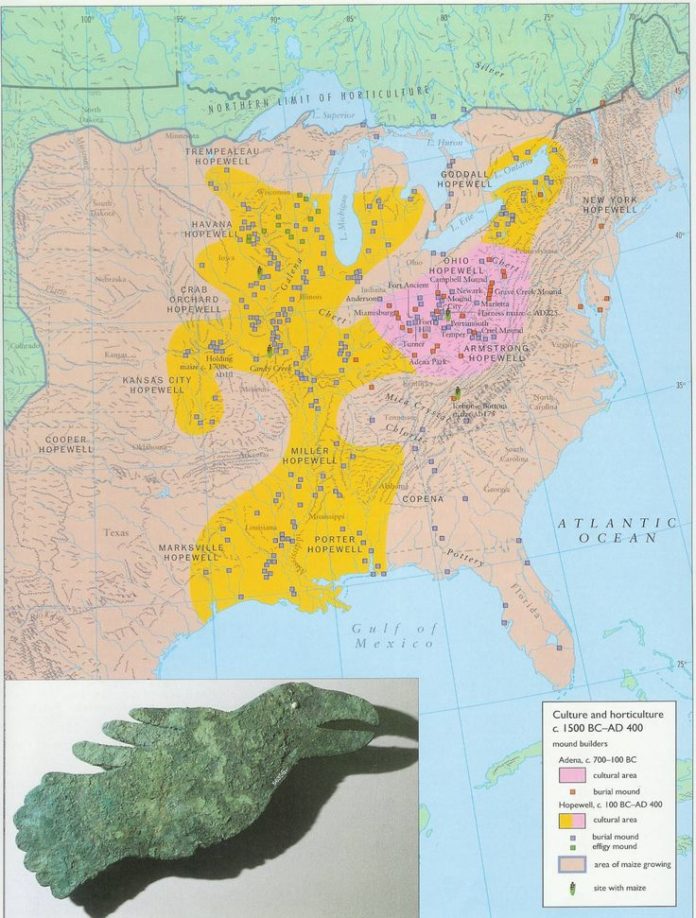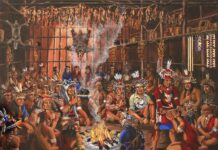At the 24th Book of Mormon Evidence Conference yesterday, I shared some information with our guests about how the Nephite Culture of the Book of Mormon from 600 BC to 400 AD, has so many amazing similarities to the Hopewell Culture in the United States. Many archaeologists, scientists and historians who aren’t members of the Church of Jesus Christ of Latter-day Saints, know and believe the history of the Hopewell Culture and verify the dating which parallels the Book of Mormon. Below you will also find the fantastic article I referenced of a discussion between Archaeologist of Ohio William Mills in 1917 with James E. Talmadge.
My talk along with all of those from this last conference will be streaming on our new online streaming service in a few weeks. Currently we have over 200 fantastic videos you can choose from. Visit HERE or the click on the picture below.
The Hopewell & Nephites- Parallel Histories

“The Hopewell culture describes the common aspects of a segment of Native American culture that flourished along rivers in the northeastern and Midwestern United States from approximately 400 B.C. to 500 A.D., a time period that nearly matches the span of the developed Nephite societies. The Hopewell peoples were not a single culture or society, but a widely dispersed set of related populations as shown on the map on the left. They were connected by a common network of trade routes, in what is known as the “Hopewell exchange system.” The name ‘Hopewell’ was chosen by Warren K. Moorehead, known as the ‘Dean of American archaeology,’ after his explorations in 1891 and 1892 of a group of mounds in Ross County, Ohio. He named the mounds after Mordecai Hopewell, the owner of the land. Subsequently all mounds that have similar identifications are named as the Hopewell Mound Builders within an interaction sphere.Currently, the Hopewell interaction sphere has come to encompass regions from the Southeastern United States as far south as the Crystal River Indian Mounds in Florida up to the southeastern Canadian shores of Lake Ontario in the north. Within this geographic area, inter societal exchanges were common along major waterways. The Hopewell exchange system received materials from all over what is now the heartland of the United States. Many objects created by the Hopewell cultures have been excavated and show a remarkable degree of commonality to items described within the text from the Nephite and Lamanite civilizations. In 1848, Ephraim George Squier, A.M., and Edwin Hamilton Davis, M.D., published the book, Ancient Monuments of the Mississippi Valley: Comprising the Results of Extensive Original Surveys and Explorations. The work was a landmark in American scientific research and was the genesis of archaeology as a scientific discipline. More importantly, the book was the first volume of the Smithsonian Institution’s Contributions to Knowledge series and the Institution’s first publication. Among Squier and Davis’ most important achievements was their systematic approach to analyzing and documenting the sites they surveyed, including Seip Mound, southwest of Chillicothe, Ohio (survey Plate XXI, No. 2 shown below on the left), which they discovered in 1846, and the mapping of the Mound City Group, also in Chillicothe, Ohio, which has been restored using their data and is now part of Hopewell Culture National Historical Park. Squier and Davis collection of ancient Mound objects can now be seen at the British Museum in London, England. A few of their maps will be used in this edition as most of those mounds they identified have been destroyed by population growth that demanded land as the United States expanded westward. Their drawings are left to us to study of what was a highly educated, cultured and civilized society with roads, highways and cities rivaling the sizes of those in Europe.
The Annotated Edition of the Book of Mormon highlights various excavated artifacts throughout the text that come from the “Mound Builder’s” earth or “dust” (Isaiah 29:4), like those found at Zelph’s Mound, providing physical or “circumstantial evidences” (Teachings of the Prophet Joseph Smith, Section Five [1842-43], 267) showing those mound builders shared common associations with the Nephite cultures. Lehi’s party arrived in the Promised Land in roughly 590 B.C. as a small group. Within a few years, those who followed Nephi separated themselves from those who followed Laman and Lemuel. By 570 B.C. the two groups, the Nephites and the Lamanites, were then living in separate geographical regions with different lifestyles. The Nephites settled in a small region maintaining their flocks, herds and crops while the followers of Laman lived as wanderers feeding off of wild animals, “becoming wicked and wild and ferocious, yea, even becoming Lamanites” (Helaman 3:16). By 500 B.C., one hundred years after leaving Jerusalem, the populations were now well into the second and third generations and growing rapidly. In 279 B.C., king Mosiah leaves the land of their first inheritance, the land of Nephi, and finds the people of Zarahemla, who are more numerous than his group (Omni 1:17), and joins with them. After learning their language, he discovers that their history parallels their arriving in the land at about the same time period when both founding groups fled Jerusalem. It is quite reasonable then, that by 200 to 100 B.C., the best dating of the beginning of the Hopewell societies, that the population within the Hopewell interaction spheres parallels the history and culture within the pages of the Book of Mormon (see Appendix, pp. 538-539, for a list of 50 correlations). Moroni, the last Nephite prophet and historian to write on his metal plates, describes the destruction of his people in about 421 A.D. Remarkably, the culture of the Mound Builders suddenly collapses between 400-500 A.D. Those groups of “Mound Builders,” who exhibited similar characteristics of the Nephites, in the working in metals, in making fine jewelry and cloth, in implementing battle armaments such as head-plates, arm-shields, breastplates, etc., and engaging in similar military tactics of digging ditches around high banks of earth such as this recorded event: “Now behold, the Lamanites could not get into their forts of security by any other way save by the entrance because of the highness of the bank, which had been thrown up and the depth of the ditch, which had been dug round about, save it were by the entrance” (Alma 49:18), have all disappeared from history. The early European settlers of North America observed Native American Indians as just savages, yet in a revelation given through the prophet Joseph Smith to Parley P. Pratt, Oliver Cowdery and Ziba Peterson, in Manchester, NY, early October 1830 the Lord declared: “And now concerning My servant Parley P. Pratt, behold, I say unto him that as I live I will that he shall declare My gospel and learn of Me, and be meek and lowly of heart. And that which I have appointed unto him is that he shall go with My servants, Oliver Cowdery and Peter Whitmer, Jun., into the wilderness among the Lamanites. And Ziba Peterson also shall go with them; and I Myself will go with them and be in their midst; and I am their advocate with the Father, and nothing shall prevail against them” (Doctrine and Covenants Section 32:1-3: emphasis added). The Lord has declared where some of the surviving Lamanites were and are—and He will be a personal guide to the help His servants in teaching them their House of Israel heritage.” Annotated Book of Mormon by David Hocking and Rod Meldrum pages 536-537. Charts below are from page 538 and 539 of the same book. Purchase Here


Parallels of the Hopewell Culture as described by William C. Mills, Chief Archaeologist of Ohio, with the Book of Mormon [May 20, 1917; Sunday] by James E Talmage
“Attended Sunday School and afternoon service in Hawthorne Hall, and was a speaker at each assembly. Evening meetings here, as also in Brooklyn, have been discontinued for the summer. The attendance both at Sunday School and afternoon meeting was surprisingly large in view of the fact that many of the Utah college students have left for the vacation period. This evening at the hotel I had a long and profitable consultation with Professor Wm. C. Mills, State Archaeologist of Ohio. He is continuing his splendid work of exploration in the Ohio mounds, and I went over with him again the remarkable agreement between his deductions and the Book of Mormon story. He has reached the following (10) conclusions: The area now included within the political boundaries defining the State of Ohio was once inhabited by two distinct peoples, representing two cultures, a higher and a lower.
These two classes were contemporaries; in other words, the higher and the lower culture represented distinct phases of development existing at one time and in contiguous sections, and furnish in no sense an instance of evolution by which the lower culture was developed into the higher.
These two cultural types or distinct peoples were generally in a state of hostility one toward the other, the lower culture being more commonly the aggressor and the higher the defender.
During limited periods, however, the two types, classes, or cultures, lived in a state of neutrality, amounting in fact to friendly intercourse.
The numerous exhumations of human bones demonstrate that the people of the lower type, if not indeed both cultures, were very generally affected by syphilis, indicating a prevalent condition of lasciviousness.
Their (are) two peoples or cultures…the lower culture was most commonly the assailing party, while the people of the higher type defended as best they could but in general fled.
As a further consequence of this belligerent status they buried their dead, with or without previous cremation, in such condition as to admit of expeditious covering up of the cemeteries by the heaping of earth over the sepulchers [sic], in which hurried work the least skilled laborers and even children could be employed.
From a careful collating of data it is demonstrated that the general course of migration through the area now defined as the State of Ohio was inward from the west and outward toward the east.
Professor Mills states that no definite data as to the age of these peoples have as yet been found, but that the mounds may date back a few hundred years or even fifteen hundred or more.
Several years ago I placed a Book of Mormon in the hands of Professor Mills and, while he is reticent as to the parallelism of his discoveries and the Book of Mormon account, he is impressed by the agreement.”
James E. Talmage 20 May 1917 See copies below from William Mills 1914 publication called Archaeological Atlas of Ohio



William Mills 1914 publication called Archaeological Atlas of Ohio

Chart above courtesy of Wayne May Ancient American Magazine here William Mills 1914 publication called Archaeological Atlas of Ohio. Entire book here:
DOES THE GEOGRAPHY OF THE BOOK OF MORMON MATTER?
When Christ appeared to the Nephites as the resurrected Savior, He blessed them, He taught them He prayed with them and for them. He also quoted to them the words of Isaiah. He reminded them that they had been given THIS LAND for their inheritance and were warned that they would not be allowed to remain on THIS LAND if they did not remain faithful. This emphasis shows the significance of THIS LAND to the Book of Mormon people, and the people who would be brought by the hand of God to THIS LAND and now occupy THIS LAND.
With over 1400 references to “this land” in the Book of Mormon,
I’m not sure how the Book of Mormon prophets could have made it clearer. THIS LAND matters. Geography matters. Those of us on THIS LAND the “promised land,” the Land of Liberty, the Land of the New Jerusalem need to know who we are. America is THIS LAND. America is a covenant land. I live on THIS LAND. Even the chapter heading of 3 Nephi also confirms this truth. The geography of the Book of Mormon matters to me.” Rod Meldrum FIRM Foundation President




Montrose Iowa.


Find More Information
You can discover more information about the connection between the Hopewell, Nephites, and Jews in Ohio in the my book, Moroni’s America-Land Bountiful Edition seen below. This 60 Map Bountiful Edition is available in a great package below.
Heartland Map Package:
Moroni’s America-Maps Edition 150 Pages, AND Moroni’s America-Land Bountiful Edition 60 Maps. 210 Total Maps, PLUS receive the All-New 20″ x 30″ Folding Travel Map. Buy ALL THREE and Save 18% here.

Below is some information from the Bountiful Edition map book.


“There was a wall at the Great Circle at the Hopeton site. For those of you interested in dry archeological research, here is more about an interesting and recent discovery at the Hopeton Great Circle (adjacent to the Cedar Bank site near Chillicothe OH and also adjacent to the Chillicothe Ward building). Typically, I try to remain abreast with the research happening each year in Ohio and nearby. I spoke with an archaeologist last summer [2017] at the site, and learned of his confirmation of anomalies indicated by a an extensive magnetometry survey. The other day in conversation, we discussed more details regarding the findings. It appears the Great Circle has evidences of a wooden fence, where the at least 6 ft height 1050 ft diameter earthen wall (enclosing 20 acres) was located. Indications are a pattern of very large posts spaced every 6 meters. This excavation last season revealed a post mold to be 96cm (about 38 inches) in diameter and 1.13 meters deep. One can estimate the height from that data. Indications are that smaller posts existed between the larger ones. The Hopeton site is significant in its location in relation to Cedar Bank, Sugarloaf, Mound City, and Dunlap Works and likely others. The current Chillicothe Ward building aligns with the Cedar Bank site (specifically the platform mound) and is within sight of Sugarloaf and in association with other major earthworks, including Hopeton. I am pretty sure Church engineering had not considered the earthworks when the building was designed.” Anthony George Lifelong Resident of Chillicothe, Ohio and Archaeological Researcher as quoted in Moroni’s America Land Bountiful Edition by Rian Nelson and Jonathan Neville


Hebrew & Hopewell DNA
“A lady by the name of Lisa Mills did her doctoral thesis on the Hopewell. She sampled 49 Hopewell burials from Mound City in Chillicothe, Ohio. They were originally excavated by Shetrone in the mid-20th century. Of the 49 she extracted Mt/DNA from 64% of them. What is significant is she found Haplogroup X in several remains. Haplogroup X is a marker that originated in Galilee. This in my opinion strongly suggests contact by the Hebrews with Hopewell. Richard D. Moats, Avocational Archaeologist, Archaeoastronomer
Purchase the New Annotated Book of Mormon here








